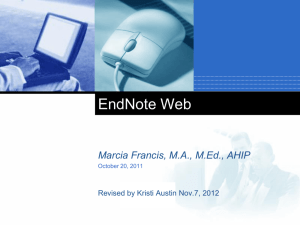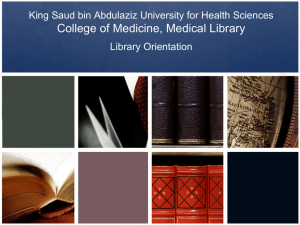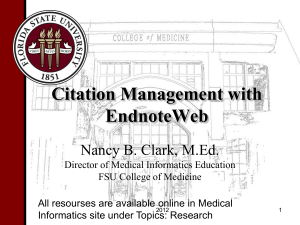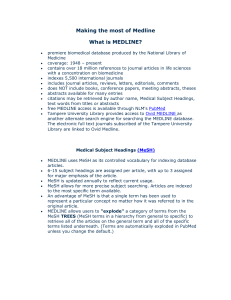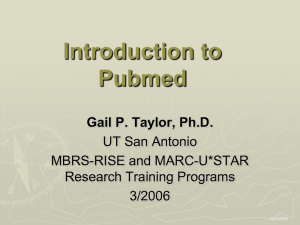Writing a Research Paper - Florida State University College of
advertisement
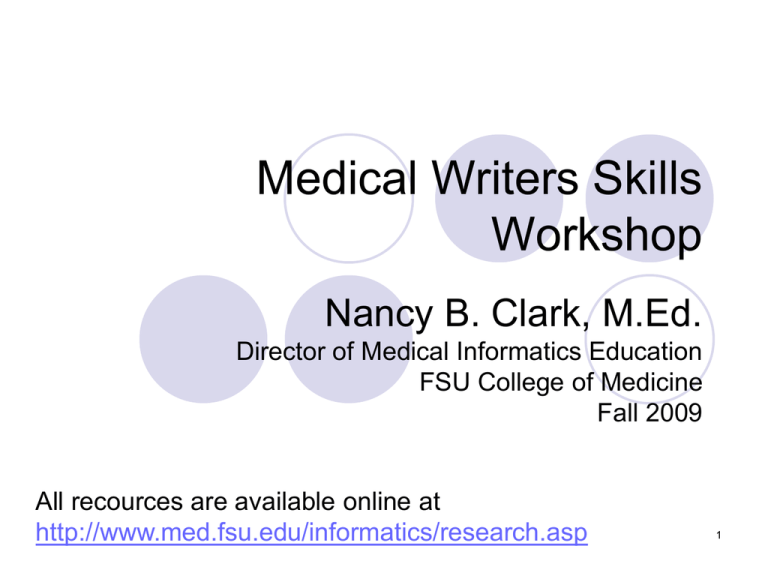
Medical Writers Skills Workshop Nancy B. Clark, M.Ed. Director of Medical Informatics Education FSU College of Medicine Fall 2009 All recources are available online at http://www.med.fsu.edu/informatics/research.asp 1 Objectives Attendees will Identify good references Perform a MEDLINE search effectively Find full text journal articles Find info in online textbooks Find online health stats Use EndnoteWeb to manage citations and references in a defined style 2 Tutorials Tutorials at Pubmed (assigned) Searching PubMed Using Mesh Terms My NCBI (optional) Tutorials on Medical Library page Using EndnoteWeb (4) Finding e-Journals (3) Tutorials at EndnoteWeb.com 3 Essential Software MSWord 2007 Endnote Web Cite While you Write plugin http://www.endnoteweb.com Stedman’s Medical Spellchecker 4 Prerequisite Word Skills Headers and footers Page numbers Fonts and sizes Paragraph formatting Page Breaks Tables and captions Page layouts Numbering or bullets Single/double spacing Hanging indents/first line indents Word Document Properly Formatted at http://www.med.fsu.edu/informatics/SampleTitlePage.doc 5 Research Paper Research Paper: In the Fall there will be a research paper that should be based on your thoughtful assessment of the readings, lecture material, assimilation with other assignments in other Year 2 classes, and class discussion. Topics for the term paper will be on health policy or patient safety/medical errors. Topics for papers are chosen by students but must be approved by the course director. One possible format for the research paper could be as follows: Part I, write an opening statement that explains why the issue you have chosen is important; Part II, provide an overview of the most important arguments and concepts supporting your topic; Part III, provide your assessment of the strengths and weaknesses of the positions reflected in Part II; Part IV, draw conclusions about the issue. The body of the paper will be 10 pages (double-spaced). The paper will require the use of “Endnote” and should have both primary and secondary references. 6 Find the References What are the best? 7 Levels of References Primary: Peer Reviewed journal articles Secondary: Primary Not peer reviewed Secondary 8 Levels of Peer Reviewed Information Primary: original research Primary Secondary: review articles Secondary Tertiary: textbooks, summaries Tertiary 9 Clarification for Paper Primary means original research on topic Secondary means everything else No set number of references requires Quality over quantity Grade not dependent on number of references 10 Primary Peer Reviewed Literature Original Research 11 Secondary Peer Reviewed Sources 12 Periodical Databases See FSU Databases A-Z ERIC (education journals) Lexis-Nexis Academic Universe (business, government, medical, legal...) Newspaper Abstracts (25 major newspapers) PsychINFO (social sciences) Web of Science (science, social science, arts and literature citations) MEDLINE (medicine) 13 What is MEDLINE? produced by the National Library of Medicine electronic version of Index Medicus, International Nursing Index, International Dental Literature 1966 – present 4,000+ international biomedical journals includes journal articles, reviews, letters, editorials, comments does NOT include books, conference papers, meeting abstracts, theses 14 MEDLINE Fields Author Title Date Type of publication Journal, Volume, Issue Page numbers Abstract Institution MeSH Headings A lot of cataloging numbers Typical Entry 15 What’s a MeSH Heading? "Medical Subject Headings" vocabulary terms from subject analysis of literature indexing journal articles for Index Medicus® and MEDLINE cataloging books and audiovisuals controlled vocabulary arranged in a hierarchical MeSH Tree Structures updated annually 16 Examples of MeSH Headings Pubmed MeSH Database 17 Where is MEDLINE? Pubmed (NLM) OVID MD Consult Google Scholar Links to Full text journal articles Books EBM databases 18 PubMed MEDLINE Entering PubMed Type search terms Tutorial Save searches in your custom ‘cubby.’ 19 PubMed MEDLINE Preliminary Results Large number of hits. Click on ‘Details’ to show how PubMed translated the search. (You can modify the search by typing in the text box.) 20 Boolean Operators AND OR NOT Parenthesis * quotes “medication errors” AND “quality improvement” NOT (ambulatory OR “nursing home”) 21 “medication errors” AND “quality improvement” NOT (ambulatory OR “nursing home”) Ambulatory Medication errors Quality improvement Nursing home 22 PubMed MEDLINE Limit Results Click on ‘Limits’ Limits added in this search: - Indexed in the last 2 years - Human subjects 23 PubMed MEDLINE Refined Results Number of hits is still quite large. (361 from previous 92,441) Add ‘AND diet therapy’ to the search terms. (AND, OR, & NOT operators must be in all capitals.) 24 PubMed MEDLINE Combining Searches Use History #2 AND #3 Click on number of hits to see results 25 PubMed MEDLINE Getting the articles Select ‘Abstract’ view and click on ‘Display’ Click on FSU icon to link to full text. 26 Related Articles AbstractPlus View Link to full text FSU subscriptions 27 28 Tricks Find one good article Look at MeSH headings in MEDLINE view Pick similar articles Search same MeSH terms Use Related Articles in PubMed 29 Too Many Hits: Increase Specificity Use more specific terms in free text search Use mesh search rather than text word search Combine searches Use more specific mesh headings Add terms (using AND) Limit language of article human or animal subjects publication types (e.g. randomized controlled trials, reviews, etc.) country year of publication 30 Too Few Hits Increase Sensitivity Find more search terms from good articles Try different combinations of terms Use truncation (*) in Text word OR Subject (ie immunoglob* ) Use OR to add and combine terms Use combination of Text word and Subject searches Select All Subheadings with Subject MeSH terms Search further back in time 31 Find Good Articles Recent Applicable Relevant Good research criteria Not just first full text article you find 32 PubMed MEDLINE Getting the articles when there is no FSU icon 4 If there is no FSU icon, there are other options: 1. Check the FSU COM ejournals page. 2. Check the FSU University Library Serials Solutions Page. 3. Check the online library catalog. If in paper, hoof it. 4. Request an Inter-Library Loan (ILL). 1 3 2 33 E-Journals In electronic less than 10 years Each journal different Digitizing old issues slowly 34 Finding Full Text Articles 1. Pubmed Linked to full text? No… 2. E-Journals list from library webpage? Not listed… 3. FSU Serial Solutions from library webpage. In electric format? No... 4. Online Library Catelog. Owned in print? No… 5. Interlibrary loans for titles not owned by FSU (link at top of Library Webpage) 35 Recommendation Create folder for articles in My Documents Save PDF of article, Creating a library of articles If no PDF, Print Preview, Copy and paste into Word document and save Add link in Endnote (Later...) 36 Searching Electronic Textbooks WebFeat Book link in PubMed 37 Librarian Consults Set up an appointment Attend group help sessions Schedule to be announced 38 Finding Health Statistics 39 Types of Health Statistics Questions Fact lookups Research Presentations Social and Policy indicators 40 Strategies for Finding Health Stats Google Search Use Portal Start at Internet site Start with book or article 41 Internet Portals of Health Stats Lists of links that provide starting points for browsing or searching Keyword search in portal vs Google General idea what you want The National Center for Health Statistics portal: http://www.cdc.gov/nchs/ DHHS Gateway to Data and Statistics Health Services Research Information Central (NLM) 42 Lexis-Nexis Statistical Universe Subscription resource Searches stat data Subject List Limit search Reports or tables http://web.lexisnexis.com/statuniv?B1=Connect+to+Statis tical+Universe 43 MMWR Morbidity – illness Mortality – death http://www.cdc.gov/mmwr/ Disease Trends Tables - searchable 44 Health Care Data Healthcare Cost and Utilization Project HCUPnet Hospital discharges Ambulatory service Costs Amount of care By diagnosis and procedure Surveys of hosp, physicians, nursing homes 45 Health Consequences Costs to society, individuals Cost from care Costs of illness Impact on infrastructure HCFA=>CMS Health Accounts http://cms.hhs.gov/ 46 State and International Data Floridahealthstat.com - Where Florida Health Data Resides KFF State Health Facts Online United Nations Statistics Division World Health Organization Research Tools 47 Citations and References Note: Endnote Web Camtasia Tutorials on Library Tutorials Page 49 Style Guides AMA Style Guide* Examples of AMA Citations Other Style Guides What do I mean by Style Guides? Format required for submitting articles to journal http://www.med.fsu.edu/informatics under Research 50 APA Style Now is the time for all good men to come to the aid of their country.(Alpay & Russell, 2002) Four score and seven years ago our forefathers brought forth a new nation conceived in liberty and dedicated to the proposition that all men are created equal.(Balen & Jewesson, 2004) References Alpay, L., & Russell, A. (2002). Information technology training in primary care: the nurses' voice. Comput Inform Nurs, 20(4), 136-142. Balen, R. M., & Jewesson, P. J. (2004). Pharmacist computer skills and needs assessment survey. J Med Internet Res, 6(1), e11. 51 JAMA Style This is the style to use. Now is the time for all good men to come to the aid of their country.1 Four score and seven years ago our forefathers brought forth a new nation conceived in liberty and dedicated to the proposition that all men are created equal.2 References 1. Alpay L, Russell A. Information technology training in primary care: the nurses' voice. Comput Inform Nurs. Jul-Aug 2002;20(4):136-142. 2. Balen RM, Jewesson PJ. Pharmacist computer skills and needs assessment survey. J Med Internet Res. Mar 29 2004;6(1):e11. 52 Paper Format Margins 1”, top, bottom, left and right 8 ½ X 11 inch white paper Portrait orientation Font: Normal: Times New Roman, 12 point Document title, Heading 2 style: Arial, 14 point, bold, italics Section titles, Heading 3 style: Arial, 13 point, bold Subsection titles, Times New Roman, 12 point, underlined Download Sample Title Page 53 Recommendation 1. Use Pubmed to find articles 2. Save PDF, Print out, read, keep or pitch, highlight 3. Do web search for government reports… 4. Print out, read, keep or pitch 5. Do eBooks search, etc 6. Find appropriate statistics 7. Other databases (newspapers) 8. Once you have all items to cite printed out… 54 EndnoteWeb Stores your references on the web Runs in Word Manages Citations Creates References Automatically formats JAMA style 55 Research Paper Endnote Library of References Now is the time for all good men to come to the aid of their country. (citation) Stack of References: Journal articles Book chapters Web sites Monographs References - Bibliographic citation - Word Document 56 First Time You Start Endnote Web 1. 2. 3. 4. www.myendnoteweb.com Set up Account UserID: email Password (must have at least 1 letter, 1 number, 1 symbol) 57 Start Endnote Web in Word 2007 X Endnote Web Tool Bar on Ribbon Will ask you to sign in 58 Use Endnote Web in Word 1. Create an Endnote Library online 2. Add all cited articles, books, websites, etc. to library 3. Set the Format to JAMA 4. As you type, Find and insert citation • Pick reference from library 5. Endnote creates the bibliography 59 Organize Your References Create New Group for this paper 60 How to Populate the Library - Options Endnote Web References Manually enter references Connect to Pubmed or other database and capture Search Pubmed or other DB and save results then import (see tutorials on Library website) In Google Scholar, WOS or OVID, search and export directly to Endnote 61 Add Citations to Library Type them in Book chapters Newspaper articles Statistical Reports Websites Let Endnote Web grab from PubMed, PsychLit, OVID, etc. Journal articles 62 How to Type in Citation In Endnote Web Collect Tab Select New Reference Pick reference type Type in fields Pick Group to save to Click SAVE 63 What Fields Do You Need to fill in? Look at or print our http://med.fsu.edu/informatics/Research.asp Examples AMA Citations 64 How to Capture References Collect Tab Online Search Pick a source Pubmed [NLM] Connect 65 Perform Search If article known Use Author and Title word Search 66 Perform Search Retrieve Articles found Pick article(s) Add to Group Pick group 67 Cite While You Write In Word 1. Put Cursor on spot 2. Endnote Web Ribbon Find Citation 3. Type author 4. Click Find 5. Click citation of choice 6. Click Insert Insert 68 Citation and Reference Appear in Word Document 69 Set AMA Style In Endnote Web Ribbon Style: dropdown Find JAMA If not there… Open Bibliography dialog box Pick JAMA under output style 70 Export References PowerPoint Reference Slides JAMA format Format > Bibliography Save as RTF Open in Word Copy and paste in PowerPoint 71 Hands on practice Do a few on your own. If you are missing Endnote Web or Stedmans, go by IT office or tell Help Desk and get them installed. 72


